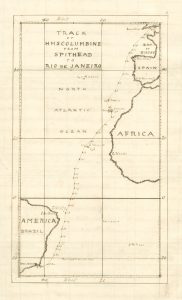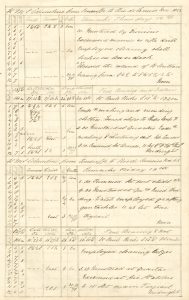June 20, 2019, by Kathryn Steenson
Rain Rain Go Away!
One of the main topics of conversation over the last week or so has been the truly atrocious weather, and even as I type this the raindrops are pattering against the office windows. This is in stark contrast to last year’s heatwave, which officially began on the 22nd June and lasted until the 7th August 2018. It’s a terrible cliche, but it’s true that Britain is obsessed with the weather and has been for quite some time.
We hold several collections of weather records in Manuscripts & Special Collections, ranging from back-garden amateur rainfall readings to official reports compiled from across the globe. These include ship’s logs, some which are in the family and estate papers as part of a much larger collection, and usually belonged to to younger sons who had careers at sea. Others, like this one, came to the University without any other associated papers. George Ross Divett was a midshipman in the Royal Navy and served on a number of ships, and in a variety of foreign locations spanning 1863-1869. One of the ships Divett served on was HMS Columbine, from which this image is taken. Divett’s detailed records provide daily information (morning, noon and midnight) on the hour, the course (knots and tenths), the distance, the winds, the force of the wind, the state of the weather, the longitude and latitude and the location of the ship. There are remarks containing information about the daily running of the ship, the routines undertaken by the crew and the positions of the sails.
This item does come from the family and estate papers, specifically the 7th Duke of Newcastle under Lyne. This is an illustrated advertising leaflet for Negretti and Zambra, producers of meteorological instruments including various rain gauges. A cross is marked next to Symons’ Snowdon Rain Gauge, a mid-range model. Presumably this is the type used by the head gardener at Clumber Park, Samuel Barker, to record the amounts of rainfall. This wasn’t an idle interest; landed families lived off the income their estates provided through rentals, farming, timber production etc, and knowledge of the weather conditions was valuable.
Even closer to home, we have the records of the weather station maintained by Nottingham University Geography Department from 1962 until 1981. Comprehensive recordings of rainfall, sunshine and temperature (and later windspeed) were began in 1962, led by lecturer Frank Barnes (1920-2003). Barnes had been a meteorological officer in the RAF during the Second World War, and brought this enthusiasm to the School of Geography, which he joined in 1947. A team of staff and postgraduate students took the readings and reset the monitoring equipment at 0900 GMT, seven days a week. The details were transcribed into a daily meteorological record, and from this monthly and annual summaries were produced, with summaries even being published for a time in the Nottingham Evening Post.

Meteorological working chart of the North Atlantic Ocean area for Christmas Day 1951; Ref: Met/Ug/15
All these weather records and more can be searched in our catalogue and viewed in the Reading Room at King’s Meadow Campus. We recommend that you email us to let us know when you’re coming and what you’d like to see.
No comments yet, fill out a comment to be the first






Leave a Reply